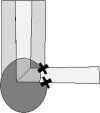Quadriceps Tendon Autograft Medial Patellofemoral Ligament Reconstruction
- PMID: 29679209
- PMCID: PMC5970111
- DOI: 10.1007/s12178-018-9476-1
Quadriceps Tendon Autograft Medial Patellofemoral Ligament Reconstruction
Abstract
Purpose: Critically evaluate the published literature related to quadriceps tendon (QT) medial patellofemoral ligament (MPFL) reconstruction.
Recent findings: Hamstring tendon (HT) MPFL reconstruction techniques have been shown to successfully restore patella stability, but complications including patella fracture are reported. Quadriceps tendon (QT) reconstruction techniques with an intact graft pedicle on the patella side have the advantage that patella bone tunnel drilling and fixation are no longer needed, reducing risk of patella fracture. Several QT MPFL reconstruction techniques, including minimally invasive surgical (MIS) approaches, have been published with promising clinical results and fewer complications than with HT techniques. Parallel laboratory studies have shown macroscopic anatomy and biomechanical properties of QT are more similar to native MPFL than hamstring (HS) HT, suggesting QT may more accurately restore native joint kinematics. Quadriceps tendon MPFL reconstruction, via both open and MIS techniques, have promising clinical results and offer valuable alternatives to HS grafts for primary and revision MPFL reconstruction in both children and adults.
Keywords: MPFL; Medial patellofemoral ligament; Patella dislocation; Patella instability; Quadriceps tendon.
Conflict of interest statement
Conflict of Interest
Christian Fink is a consultant for Karl Storz, Medacta and Zimmer Biomet and reports royalties from Karl Storz. The other authors have no conflict of interest.
Human and Animal Rights and Informed Consent
This article does not contain any studies with human or animal subjects performed by any of the authors.
Figures









Similar articles
-
Comparison of Patellofemoral Kinematics and Stability After Medial Patellofemoral Ligament and Medial Quadriceps Tendon-Femoral Ligament Reconstruction.Am J Sports Med. 2020 Jul;48(9):2252-2259. doi: 10.1177/0363546520930703. Epub 2020 Jun 18. Am J Sports Med. 2020. PMID: 32551965
-
Medial patellofemoral ligament (MPFL) reconstruction using quadriceps tendon autograft provides good clinical, functional and patient-reported outcome measurements (PROM): a 2-year prospective study.Knee Surg Sports Traumatol Arthrosc. 2019 Aug;27(8):2426-2432. doi: 10.1007/s00167-018-5226-6. Epub 2018 Oct 29. Knee Surg Sports Traumatol Arthrosc. 2019. PMID: 30374571
-
Biomechanical comparison of two medial patellofemoral ligament reconstruction techniques: Quadriceps tendon fixation versus single-tunnel patella fixation with gracilis autograft did not differ in load to failure and stiffness.Knee. 2021 Dec;33:169-175. doi: 10.1016/j.knee.2021.09.007. Epub 2021 Oct 6. Knee. 2021. PMID: 34626887
-
Recognition of evolving medial patellofemoral anatomy provides insight for reconstruction.Knee Surg Sports Traumatol Arthrosc. 2019 Aug;27(8):2537-2550. doi: 10.1007/s00167-018-5266-y. Epub 2018 Oct 28. Knee Surg Sports Traumatol Arthrosc. 2019. PMID: 30370440 Review.
-
Anterior Cruciate Ligament Reconstruction: A Systematic Review and Meta-analysis of Outcomes for Quadriceps Tendon Autograft Versus Bone-Patellar Tendon-Bone and Hamstring-Tendon Autografts.Am J Sports Med. 2019 Dec;47(14):3531-3540. doi: 10.1177/0363546518825340. Epub 2019 Feb 21. Am J Sports Med. 2019. PMID: 30790526
Cited by
-
Comparable postoperative outcomes in patients treated with either open or arthroscopic trochleoplasty for patella dysplasia.Knee Surg Relat Res. 2024 Dec 2;36(1):41. doi: 10.1186/s43019-024-00247-0. Knee Surg Relat Res. 2024. PMID: 39623489 Free PMC article.
-
Reconstruction of medial patellofemoral ligament with adductor magnus tendon for recurrent patellar dislocation in children: a retrospective comparative cohort study.J Orthop Surg Res. 2023 Sep 27;18(1):733. doi: 10.1186/s13018-023-04221-6. J Orthop Surg Res. 2023. PMID: 37759293 Free PMC article.
-
Medial Patellofemoral Ligament Reconstruction With Quadriceps Tendon Using an Expanding PEEK Anchor.Arthrosc Tech. 2025 Apr 2;14(6):103531. doi: 10.1016/j.eats.2025.103531. eCollection 2025 Jun. Arthrosc Tech. 2025. PMID: 40656693 Free PMC article.
-
Additional head of the rectus femoris muscle: a case report.Surg Radiol Anat. 2022 Jun;44(6):829-834. doi: 10.1007/s00276-022-02937-4. Epub 2022 Apr 19. Surg Radiol Anat. 2022. PMID: 35438333
-
Minimal invasive medial patellofemoral ligament reconstruction using quadriceps tendon with de novo technique and arthroscopic guided: A case report.Int J Surg Case Rep. 2024 Sep;122:110144. doi: 10.1016/j.ijscr.2024.110144. Epub 2024 Aug 10. Int J Surg Case Rep. 2024. PMID: 39128217 Free PMC article.
References
-
- Shah JN, Howard JS, Flanigan DC, Brophy RH, Carey JL, Lattermann CA. Systematic review of complications and failures associated with medial patellofemoral ligament reconstruction for recurrent patellar dislocation. Am J Sports Med. 2012;40(08):1916–1923. doi: 10.1177/0363546512442330. - DOI - PMC - PubMed
Publication types
LinkOut - more resources
Full Text Sources
Other Literature Sources

